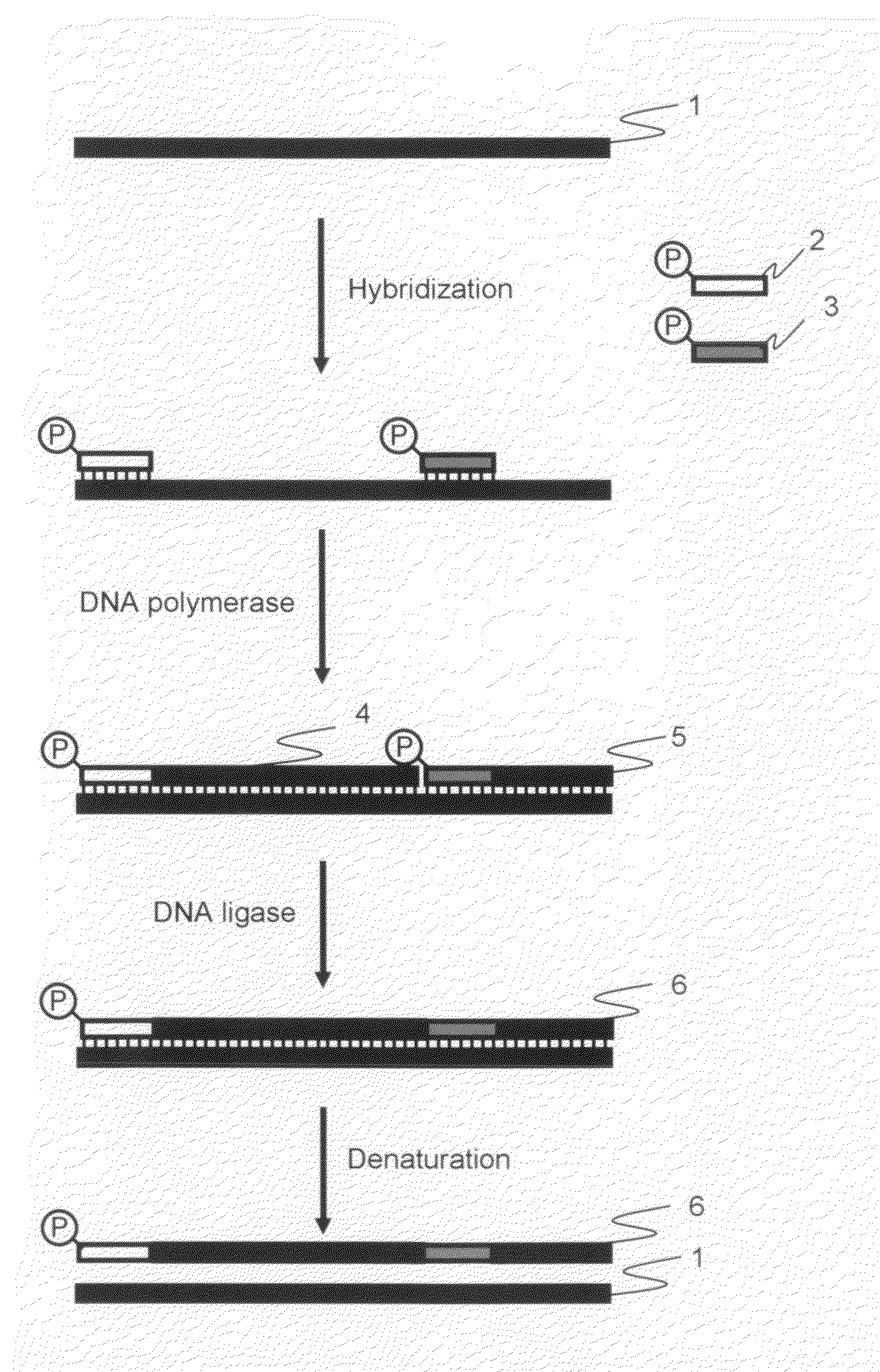Method for amplification of long nucleic acid
a nucleic acid and amplification technology, applied in the field of amplification of long nucleic acid, can solve the problems of insufficient conventional pcr method, difficulty in obtaining a sufficient amount of genetic resources, and becoming an issu
- Summary
- Abstract
- Description
- Claims
- Application Information
AI Technical Summary
Benefits of technology
Problems solved by technology
Method used
Image
Examples
example 1
1. Oligonucleotide Primers Used in Example 1
[0040]
Primer 1:(SEQ ID NO: 1)5′-AACCACCATCAAACAGGATTTTCGCCTGCT-3′Primer 2:(SEQ ID NO: 2)5′-ACCGGATACCTGTCCGCCTTTCTCCCTTCG-3′Primer 3:(SEQ ID NO: 3)5′-AAAACCGTCTATCAGGGCGATGGCCCACTA-3′
[0041]The amplified products obtained by the cooperative reaction, which were performed the elongation reaction and ligation reaction using DNA polymerase and DNA ligase cooperatively (hereinafter referred to as “cooperative reaction”) during isothermal reaction, were analyzed by electrophoresis in order to determine whether or not the long nucleic acid fragments amplification could be carried out in accordance with the procedure according to the first and second embodiments of the present invention.
[0042]pET21a vector DNA (Takara Bio Inc.) treated with a restriction enzyme HpaI (concentration: 25 ng / μL) was used as a template, and the primers described in the above 1 were used as the oligonucleotide primers for amplification. The HpaI cleavage site of pET21a ...
example 2
1. Oligonucleotide Primers Used in Example 2
[0046]
Primer 4: (AE07)5′-GGAAAGCGTC-3′(SEQ ID NO: 4)Primer 5: (AA12)5′-GGACCTCTTG-3′(SEQ ID NO: 5)Primer 6: (AZ17)5′-CACGCAGATG-3′(SEQ ID NO: 6)Primer 7: (AA20)5′-TTGCCTTCGG-3′(SEQ ID NO: 7)Primer 8: (AE02)5′-TCGTTCACCC-3′(SEQ ID NO: 8)
[0047]The reaction products were analyzed by electrophoresis in order to determine that whether or not the same amplified products could be obtained using random primers as the primers in accordance with the procedure according to the first and second embodiments of the present invention.
[0048]pET21a vector DNA (Takara Bio Inc.) treated with a restriction enzyme HpaI (concentration: 25 ng / μL) was used as a template, and the primers described in the above 1 were used as the oligonucleotide primers for amplification. Five kinds of primers (AA12, AA20, AE02, AE07, and AZ17) commercially available from Operon Technologies, Inc. were modified with T4 Polynucleotide Kinase (Takara Bio Inc.) to add a phosphate grou...
example 3
1. Oligonucleotide Primers Used in Example 3
[0052]
Primer 1:(SEQ ID NO: 1)5′-AACCACCATCAAACAGGATTTTCGCCTGCT-3′Primer 2:(SEQ ID NO: 2)5′-ACCGGATACCTGTCCGCCTTTCTCCCTTCG-3′Primer 3:(SEQ ID NO: 3)5′-AAAACCGTCTATCAGGGCGATGGCCCACTA-3′
[0053]The amplified products were analyzed by electrophoresis in order to determine whether or not long nucleic acid fragments amplification could be carried out in accordance with the procedure according to the third embodiment of the present invention.
[0054]pET21a vector DNA (Takara Bio Inc.) treated with a restriction enzyme HpaI (concentration: 25 ng / μL) was used as a template, and the primers described in the above 1 were used as the oligonucleotide primers for amplification. The HpaI cleavage site of pET21a vector DNA be defined as the first nucleotide, Primer 1 was a forward primer having a sequence which was complementary to a region between nucleotide positions 1 to 30. Primer 2 was a forward primer having a sequence which was complementary to a regio...
PUM
| Property | Measurement | Unit |
|---|---|---|
| temperature | aaaaa | aaaaa |
| concentration | aaaaa | aaaaa |
| pH | aaaaa | aaaaa |
Abstract
Description
Claims
Application Information
 Login to View More
Login to View More - R&D
- Intellectual Property
- Life Sciences
- Materials
- Tech Scout
- Unparalleled Data Quality
- Higher Quality Content
- 60% Fewer Hallucinations
Browse by: Latest US Patents, China's latest patents, Technical Efficacy Thesaurus, Application Domain, Technology Topic, Popular Technical Reports.
© 2025 PatSnap. All rights reserved.Legal|Privacy policy|Modern Slavery Act Transparency Statement|Sitemap|About US| Contact US: help@patsnap.com



